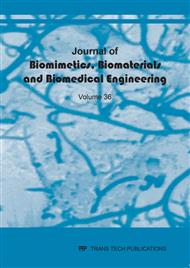[1]
B. Watier, Mechanical Behavior of the Cervical Spine: A Literature Review Mechanical Behavior of Cervical Spine: Literature update, ITBM-RBM 27 (2006) 92–106.
DOI: 10.1016/j.rbmret.2006.05.006
Google Scholar
[2]
Cédric BARREY. Biomechanical evaluation of a cervical prosthesis. In vitro and in vivo analyzes. Doctoral School No. 432: Engineering Sciences P11, pp.37-38.
Google Scholar
[3]
Haluk Kucuk. Biomechanical analysis of cervical spine sagittal stiffness characteristics. Computers in Biology and Medicine 37 (2007) 1283 – 1291.
DOI: 10.1016/j.compbiomed.2006.11.014
Google Scholar
[4]
Neil R. Crawford, PhD, Seungwon Baek, MS a, Anna G.U. Sawa, MS a, Sam Safavi-Abbasi, MD b, Volker K.H. Sonntag, MD, Neil Duggal, MD . Biomechanics of a Fixed–Center of Rotation Cervical Intervertebral Disc Prosthesis. The International Journal of Spine Surgery xx (2012).
DOI: 10.1016/j.ijsp.2011.10.003
Google Scholar
[5]
Seok Woo Kim, MD, PhD, Sang-Hoon Paik, MD, Paolo Antonio F. Castro, MD, Suk-Woo Baek, MD, Dong-Jou Shin, MD, Yoon-Hae Kwak, MD, Young-Su Ju, MD, MPh, PhD. Analysis of factors that may influence range of motion after cervical disc arthroplasty. The Spine Journal 10 (2010).
DOI: 10.3822/ijtmb.v8i3.295
Google Scholar
[6]
Jon Park, Jun Jae Shin , Jesse Lim, Biomechanical Analysis of Disc Pressure and Facet Contact Force After Simulated Two-Level Cervical Surgeries (Fusion and Arthroplasty) and Hybrid Surgery. 2014 Dec; 82(6):1388-93.
DOI: 10.1016/j.wneu.2014.06.013
Google Scholar
[7]
Paul A. Anderson, MD, Rick C. Sasso, MD, Jeffrey P. Rouleau, PhD, Cathy S. Carlson, DVM, PhDd, Jan Goffin, MD, PhDe. The Bryan Cervical Disc: wear properties and early clinical results. The Spine Journal 4 (2004) 303S–309S.
DOI: 10.1016/j.spinee.2004.07.026
Google Scholar
[8]
J.-M. Vital , L. Boissière. Total disc replacement. Orthopaedics & Traumatology: Surgery & Research 100 (2014) S1–S14.
DOI: 10.1016/j.otsr.2013.06.018
Google Scholar
[9]
Bryan W. Cunningham, MSc. Basic scientific considerations in total disc arthroplasty. The Spine Journal 4 (2004) 219S–230S.
Google Scholar
[10]
Bruce V. Darden, II, MD. ProDisc-C Cervical Disk Arthroplasty. Semin Spine Surg 24:8-13 © 2012 Elsevier Inc. All rights reserved.
Google Scholar
[11]
Jau-Ching Wu, MD, Scott A. Meyer, MD, Gurpreet Gandhoke, MD, and Praveen V. Mummaneni, MD PRESTIGE Cervical Arthroplasty: Past, Present, and Future. Semin Spine Surg 24:14-19 © 2012 Elsevier Inc. All rights reserved.
DOI: 10.1053/j.semss.2011.11.004
Google Scholar
[12]
Fabio Galbusera, Chiara M. Bellini , Manuela T. Raimondi, Maurizio Fornari , Roberto Assietti. Cervical spine biomechanics following implantation of a disc prosthesis. Medical Engineering & Physics 30 (2008) 1127–1133.
DOI: 10.1016/j.medengphy.2008.02.002
Google Scholar
[13]
Sudeep Taksali, MDa, Jonathan N. Grauer, MD, Alexander R. Vaccaro, MD. Material considerations for intervertebral disc replacement implants. The Spine Journal 4 (2004) 231S–238S.
DOI: 10.1016/j.spinee.2004.07.012
Google Scholar
[14]
Zhong Jun Mo, Yan Bin Zhao, Li Zhen Wang, Yu Sun, Ming Zhang, Yu Bo Fan. Biomechanical effects of cervical arthroplasty with U-shaped discimplant on segmental range of motion and loading of surroundingsoft tissue. Eur Spine J (2014) 23:613–621.
DOI: 10.1007/s00586-013-3070-4
Google Scholar
[15]
Sanghita Bhattacharya, BS, Vijay K. Goel, PhD, Xia Liu, PhD, Ali Kiapour, PhD, Hassan A. Serhan, PhD. Models that incorporate spinal structures predict better wear performance of cervical artificial discs. The Spine Journal 11 (2011) 766–776.
DOI: 10.1016/j.spinee.2011.06.008
Google Scholar
[16]
Nikhil Kulkarni, Effects of Implant Design Parameters on Cervical Disc Arthroplasty Performance and Sagittal Balance - A Finite Element Investigation, the University of Toledo August 2010 P71-84.
Google Scholar
[17]
Bruce V. Darden, II, MD. ProDisc-C Cervical Disk Arthroplasty. Semin Spine Surg 24:8-13 © 2012 Elsevier Inc. All rights reserved.
Google Scholar
[18]
Prodisc-C. Prothèse modulaire de disque intervertébral pour la restauration de la hauteur discale et de la mobilité segmentaire dans le rachis cervical.www.synthesprodisc.com.
DOI: 10.1007/978-2-287-99074-8_2
Google Scholar
[19]
Riadh Bahloul. Optimisation of the bending process of high strength low alloy sheet mtetal. École Nationale Supérieure d'Arts et Métiers Centre d'Angers. N° d'ordre : 2005-17. P 56, 57.
Google Scholar
[20]
Jean Christophe CURSOLLE. Lumbar disc prosthesis. Clinical and radiological results of a series of 124 patients. University Bordeaux 2 - victor segalen u.f.r. medical sciences.( 2007 ) P13.
Google Scholar
[21]
J. BANDET. Biomechanical Study of Thorax Head Connection. Bulletin No. 28. December (1971).
Google Scholar
[22]
Sean P. Moroney, Albert B. Schultz, James A. A. Miller and Gunnar B. J. Andersson. Load-Displacement Properties of Lower Cervical Spine Motion Segments, J. Biomechanics, Vol. 21. N°9, pp.769-779, (1988).
DOI: 10.1016/0021-9290(88)90285-0
Google Scholar
[23]
Joel A. Bauman, MD, Nicolas V. Jaumard, PhD, Benjamin B. Guarino, BSEb, Christine L. Weisshaar, MS, Daniel E. Lipschutz, BSE, William C. Welch, MD, Beth A. Winkelstein, PhD. Facet joint contact pressure is not significantly affected by ProDisc cervical disc arthroplasty in sagittal bending: a single-level cadaveric study. The Spine Journal - (2012).
DOI: 10.1016/j.spinee.2012.08.013
Google Scholar
[24]
van den Broek, P.R. Development of a biomimetic artificial intervertebral disc. Technische Universiteit Eindhoven.
Google Scholar
[25]
Sanghita Bhattacharya, Second Vijay K. Goel. Wear Outcomes of a Metal on Metal Disc Arthroplasty – A Computational Model. International Journal of Mechanics and Applications (2013), 3(5A): 13-21.
Google Scholar
[26]
Haiyun Li, Zheng Wang. Intervertebral disc biomechanical analysis using the finite element modeling based on medical images. Computerized Medical Imaging and Graphics 30 (2006) 363–370.
DOI: 10.1016/j.compmedimag.2006.09.004
Google Scholar


